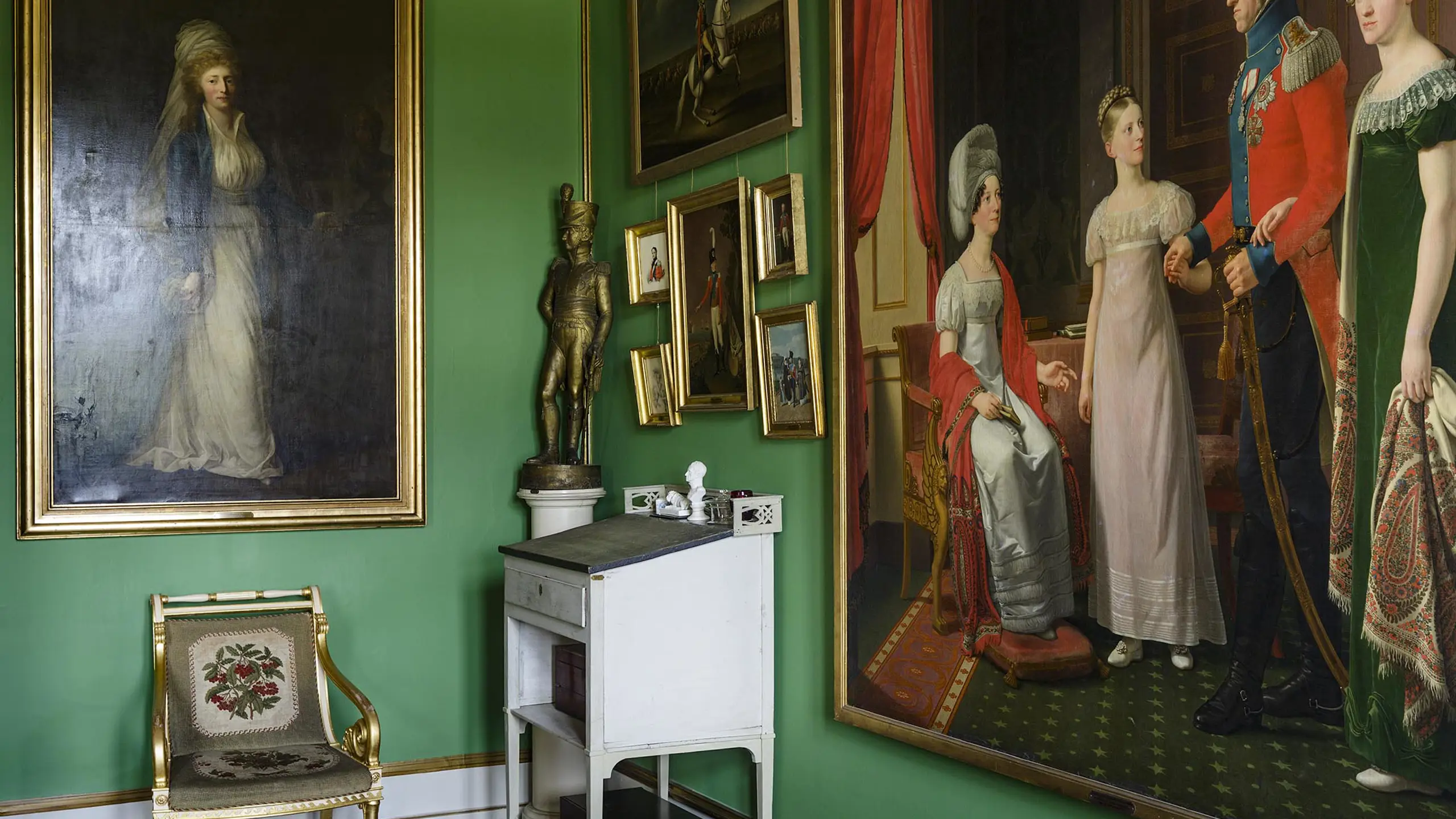Frederik VI’s Room (room 16)
Frederik VI was the son of Christian VII, and from 1784, he ruled in his father’s stead. Thus, Frederik VI was the de facto King long before he officially took to the throne.

Frederik VI and his time
The history and decoration of the room
Frederik VI never stayed here at Rosenborg Castle, so he never used this room. Like Frederik V’s Room and Christian VII’s Room, it was decorated by Johannes Wiedewelt in 1782–1784 to house the Royal Coin and Medal Collection. It was not until the castle was converted into a museum, during the mid-19th century, that this room was decorated with art and objects from the reign of Frederik VI and named it Frederik VI’s Room.
The furniture and artisanal objects in this room are in the so-called Empire style: a particular neoclassical style that developed in France after the French Revolution (1789–1799). At the height of the Empire period, the source of inspiration was the period of the ancient Roman Empire, in contrast to the neoclassical Louis Seize style, which found its ideals in ancient Greece and Egypt.
Frederik VI and the early 19th century
Frederik VI (1768–1839) was the King of Denmark from 1808 but was the acting king from 1784. This was rough period for Denmark, which was hard hit by a number of major events, including the Battle of Copenhagen in 1801, the Bombardment of Copenhagen in 1807 and the bankruptcy of the state. However, even though the early 19t century were a time of economic and military decline for Denmark, the country flourished culturally, and the first half of the century is known as the Golden Age of Danish art and literature.
Objects in the room
If you are at the museum, you can admire the fascinating objects in the room and read more about them below.
The descriptions are brief and generally do not include images. They are intended as an added resource if you would like more detailed information about an item, such as who made it, its origin and its meaning.
-
1601Princess Vilhelmine, daughter of Frederik VI; full length, painted by L. Aumont, 1831.
-
1602Chair of gilt carved wood with velvet covering. Made for Princess Caroline Amalie's throne-room in Christian VIII's Palace c. 1830. Designed by G.F. Hetsch?
-
1604Child's chair; used by Frederik VI as a child.
-
1605Princess Louise Augusta. Full length, painted 1791 by Anton Graff.
-
1611Frederik VI; statuette in bronzed plaster of Paris, c. 1810.
-
1612Frederik VI in the uniform of the Life Guards; painted by C.W. Eckersberg, 1826.
-
1613Ferdinand, the Heir Presumptive. Watercolour by L. Grünbaum, 1829.
-
1614Caroline, the Heiress Presumptive. Watercolour by L. Grünbaum, 1829.
-
1615Frederik VI as Prince, about 1805. Full length, presumably painted by W. Haffner.
-
1616Frederik VI walking with his family in Frederiksberg Gardens, about 1813. Watercolour by J. Senn.
-
1617Frederik VI's desk from Amalienborg.
-
1619Frederik VI with Queen Marie Sophie Frederikke and the Princesses Caroline and Wilhelmine; painted by C.W. Eckersberg, 1821.
-
1620Frederik VI driving across Kongens Nytorv by torchlight, 1820: painted by C.A. Lorenzen.
-
1621Frederik VI's funeral service in Roskilde Cathedral. Painted by G. Zeuthen.
-
1622Queen Marie Sophie Frederikke, drawn in 1810 by J.P. (?) Møller after painting by Jens Juel.
-
1623Frederik VI in his coronation robes. Sketch by Vilhelm Bendz, 1830.
-
1624Frederik VI's telescope, later used by Frederik VII. Signed: J. Bidstrup, London.
-
1627Small carved iron box with gold inlay (the Danish coat-of-arms). Inside is a miniature rifle, signed: J. Löbnitz.
-
1628Case for Frederik VI's water bottle.
-
1629Frederik VI's telescope.
-
1630Frederik VI's field pocket book, and a manoeuvre map of the environs of Copenhagen c. 1805.
-
1631Frederik VI's pair of compasses for the manoeuvre maps; made in Copenhagen in 1795 by J.F.B. Oppen.
-
1632Frederik VI's pedometer.
-
1634Turkish scimitar, with gold hilt and sheath. A present to Frederik VI from the Queen of Akim (in Ghana) who in 1824-26, as Denmark's ally, vanquished the King of Ashanti and seized his treasures.
-
1635Tobacco pipe of gold, presented by the same Queen to a Danish general.
-
1636Princess Caroline; three quarter length portrait by L. Aumont, 1830.
-
1639Throne of carved white painted and gilded wood, with velvet covering. Designed in 1812 by C.F. Hansen, and used by Princess Caroline in her Audience Chamber in Bernstorff's Palace.